Blog
Close Readings Series III: Innocent Failure in the System
15 October 2020 Thu
This series of Close Readings emerged from a deficiency I observed both in contemporary art criticism and in my own writing practice: Although exhibition criticism, interviews, and monographic artist texts are produced regularly, focusing on a single work, interpreting, and analyzing that one work is a form we encounter less often.
In the Close Readings Series, I focus on the works from the Borusan Contemporary Art Collection, one at a time, and aim to produce texts on the works that I am curious about and want to further elaborate on. My expectation from these texts is that they are new and experimental, bring a fresh perspective to the work rather than to adorn it, and take both me and the reader to places we have never been to before.
—Nergis Abıyeva
Bengü Karaduman's work titled Innocent Failure in the System has been intriguing me for a long time; I've recently been more haunted by it. I establish an organic relationship with the work of Karaduman, with the desolateness I feel in the never-ending "today" 1 when countless women are killed every day and as we are constantly exposed to news of violence.
The medium of Innocent Failure in the System is photography. We see that the photograph of the artist taken from the profile is in the center of the plane where she is located. Karaduman appears to be pulling on a thick rope, with 12 ropes on her back either pulling her or which tie her down. I'm not sure if Innocent Failure in the System is a manipulated photo or exactly what parts of the photo were constructed. Looking at the work, the only thing I’m certain of is that at the center of the composition is the woman, the artist.

Bengü Karaduman, Innocent Failure in the System, 2010.
56 x 120 cm, C-print, plexiglass.
The artist wears an outfit that matches her black hair, similar to a comfortable acrobat costume, covering her entire body except her hands, feet, and face. The artist is standing in an undefıned space, which can be anywhere and nowhere at the same time. It is not clear whether she is in the air or on land. If the artist opens her folded legs straight down, she will not fit into the space she is in. Innocent Failure in the System has evoked a feeling of being stuck since the first time I saw it, triggering a claustrophobic reaction.
The passing of the feeling from the artist’s experience to the audience brought to my mind Griselda Pollock's famous text, Modernity and Spaces of Femininity 2 . Pollock categorized the spaces in the paintings of artist women of Impressionism such as Mary Cassatt and Berthe Morisot: dining rooms, study rooms, bedrooms, balconies, patios, private gardens. Unlike the pictures that their male colleagues painted in cafes, bars and streets, these spaces were domestic and private. Pollock was speculatively discussing the relationship of these spaces with some ideological and social data on gender in the19th century bourgeois society. What is important for the scope of this article is Pollock's determination that a kind of tightness and intimacy had been created in Morisot and Cassat's paintings. Pollock stated that the plane of the painting was arranged in a way to position the viewer in the artist's work area, so that the mood of the artist passed on to the viewer. Karaduman's Innocent Failure in the System creates a volumetric congestion and claustrophobia. The tension created by the rope that Karaduman is trying to hold on to and the ropes trying to hold her from behind are perceived as another reason for the congestion.
So, is Karaduman taking on an actor role as an artist by wearing an acrobat suit? Merve Ünsal stated that Karaduman was questioning what it meant to act by assigning herself the role of being an actress, an agent: “This could be entrapment in a certain role assigned by society, or it could equally be a rite of passage or it could be existential angst or it could be a self-reflexive gesture of contemplating on artistic production.” 3 I would like to emphasize being a woman artist 4 by adding another perspective to this reading that Ünsal made about being an artist. Because Innocent Failure in the System echoes many questions in my mind one after the other: What does it mean to be an artist woman today? While the difficulties experienced by 19th century Impressionist artist women or 20th century modernist women artists are being discussed in relation to the social gender roles assigned to them, are we able to discuss the circumstances that contemporary women artists experience in today’s Turkey? Are we able to trace the discriminations and privileges or do we have a tendency to legitimize them?
While we can easily detect that the students who study art in universities are predominantly women, are we aware of the disadvantages these artist candidates face in the coming years in comparison to their male colleagues? What kind of data is there when the exhibitions held in institutions are analyzed from a gender perspective? 5 What has changed since the question "Why are there no great women artists" asked by Linda Nöchlin in 1971? Or are we waiting for at least a century to pass before we can talk about all this? I do not suggest looking at art and life only from a gender perspective, but I would like to remind you that Ursula K. Le Guin 6 suggested that the power of truth is also derived from statistics. 7
My answers point to the infinite situations and discourses derived from the words system, innocent, and failure. The transitions between Innocent Failure in the System and my state of mind appear to highlight the endless nature of these dialogues, questions, and answers.
1 To follow what is happening: http://www.kadincinayetlerinidurduracagiz.net
2 Griselde Pollock, Modernity and the Spaces of Femininity, 1988, https://msu.edu/course/ha/446/griseldapollock.pdf, last accessed August 15, 2020
3 Merve Ünsal, On Bengü Karaduman’s Innocent Failure in the System, December 20, 2019, https://www.borusancontemporary.com/en/blog-on-innocent-failure-in-the-system_908
4 Instead of saying "woman artist", I prefer to say "artist woman" by taking the womanhood as the main focus. I saw this use for the first time in an article by Canan Beykal. Later, my artist friend Züleyha Altıntaş informed me that Muhibbe Darga also wrote "woman artist, woman painter, woman doctor" in the book Woman in Hellenic Civilization in Greece.
5 At this point, ATILKUNST's work titled Modernized Audio Services Sub-Industry comes to mind, exhibited in Dream and Reality at Istanbul Modern in 2011. When Atılkunst (Gülçin Aksoy, Gözde İlkin, Yasemin Nur) visited the permanent collection of the museum and listened to the audio guide of this collection, they realized that not even one of the artist women in the collection was included in the audio guide. The work can be heard here: https://soundcloud.com/at-lkunst
6 Ursula K. Le Guin talks about social gender statistics in her The Wave in the Mind.
7 For research on the participation of women in 28 institutions specially in between the years 2012-2015 (museums and galleries) in Turkey, see Rumeysa Kiger’s The participation of women in the labor force in the visual arts sector: The Case of Istanbul, 2012-2015, Bilgi University, unpublished master's thesis.
ABOUT THE WRITER
Nergis Abıyeva (1991) is an art historian, art critic and curator, based in Istanbul. Currently a PhD candidate at the Istanbul Technical University (İTÜ), Abıyeva graduated from Mimar Sinan Fine Arts University’s Art History department with the thesis “The Tracks of Dadaism on Surrealism” on the honor roll. During her undergratude studies, Abıyeva studied at the Brera Academy. She then graduated from the Mimar Sinan Fine Arts University’s MA Program in Western and Contemporary Art with the master thesis, "The Art and Life of Tiraje Dikmen”. She won a Research Grant from SALT (İstanbul) with her research Tiraje Dikmen’s life and art in the context of Turkish artists who went to Paris in the 1950s. Abıyeva worked at Maçka Sanat Galerisi between 2015 and 2017 as an archivist for the 40th Year projects and contributed to the organization of the archive exhibitions. She is the assistant editor of the book, Görünmeyene Bakmak. Between 2017 and 2019, she worked at a private collection based out of Istanbul. Between April 2019-December 2020, she worked as a researcher at ARTER.
Her articles have appeared from 2015 onwards in periodicals including Sanat Dünyamız, Varlık, PRŌTOCOLLUM, Genç Sanat Dergisi, Istanbul Art News, Birikim and Argonotlar. She has curated the exhibitions, Kendiliğinden/Per se (Bilsart, 2020); Marvelous correspondences, subtle resemblences (Mixer, 2021). A member of AICA (International Association of Art Critics) Turkey since 2017, Abıyeva has been facilitating seminar programs and independent courses on modern and contemporary art since 2019.




